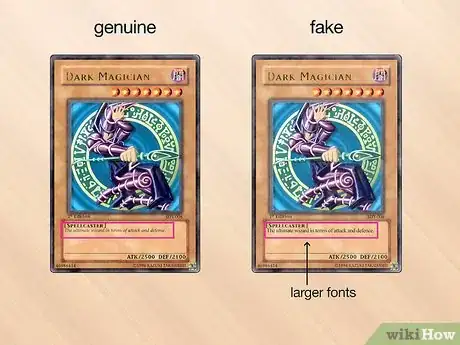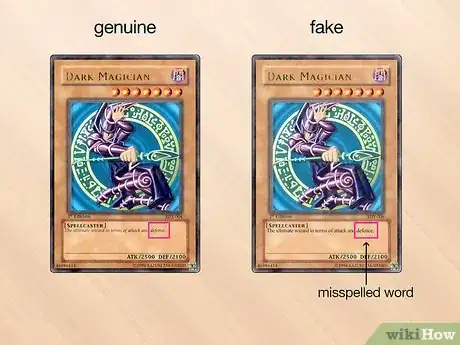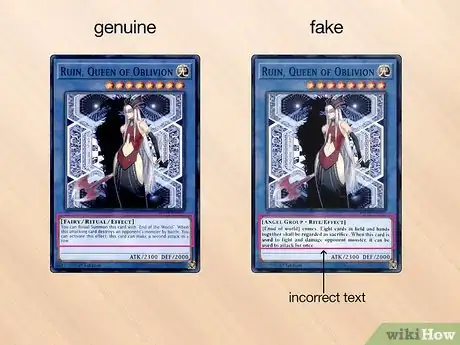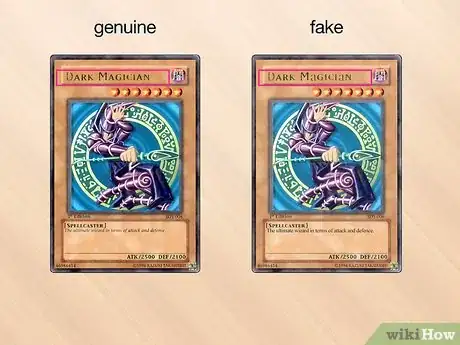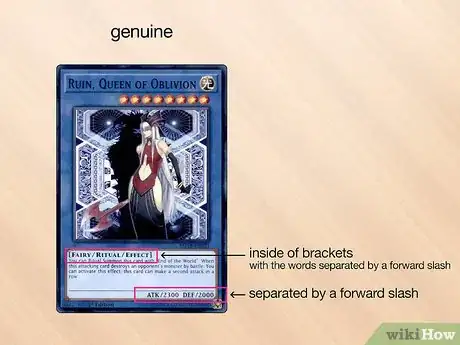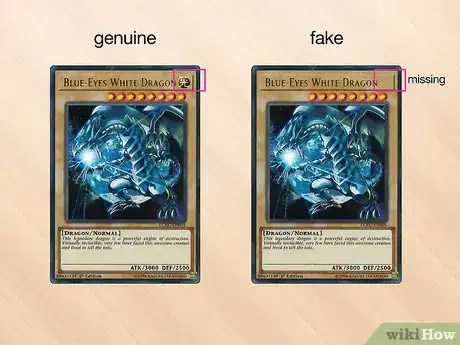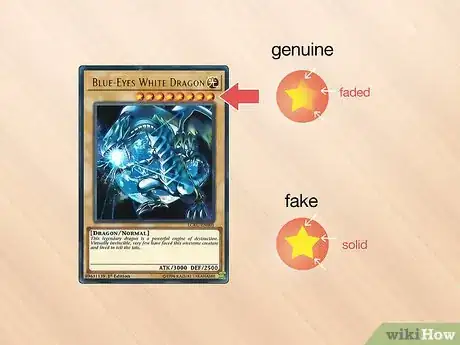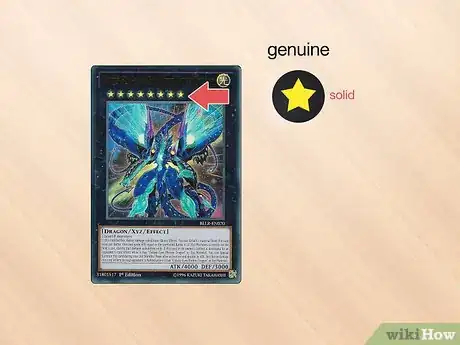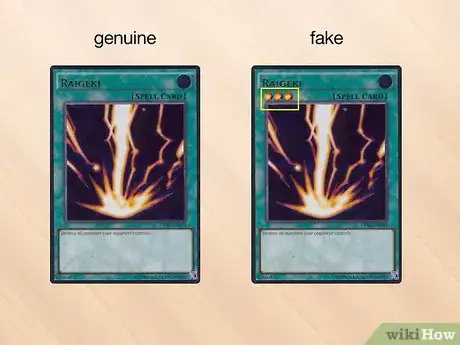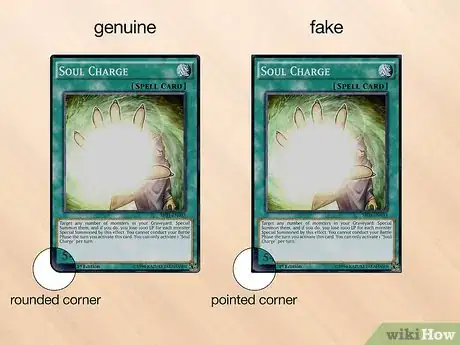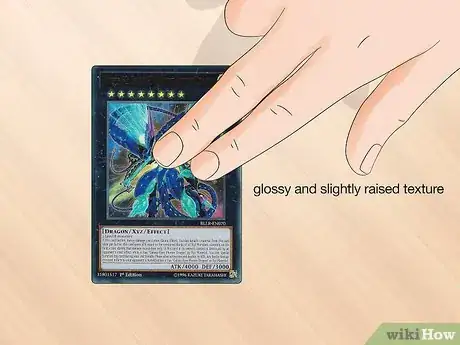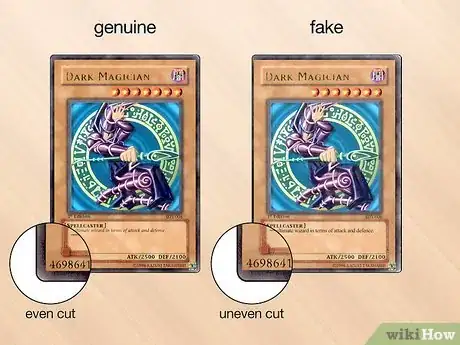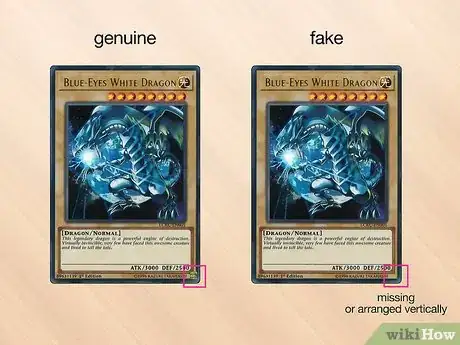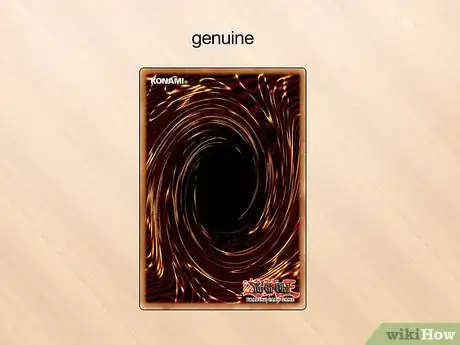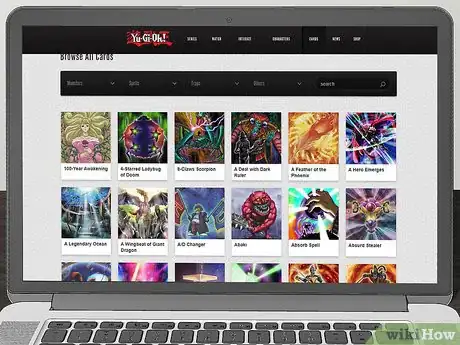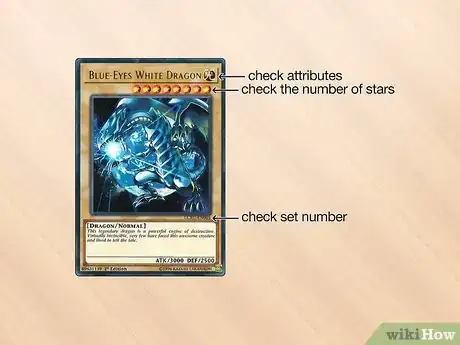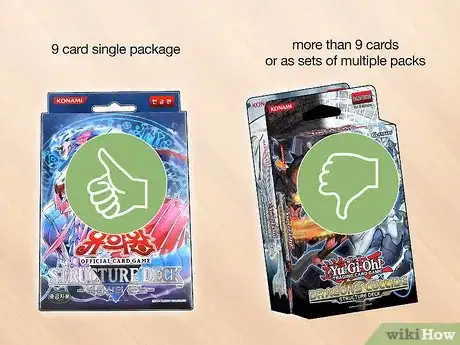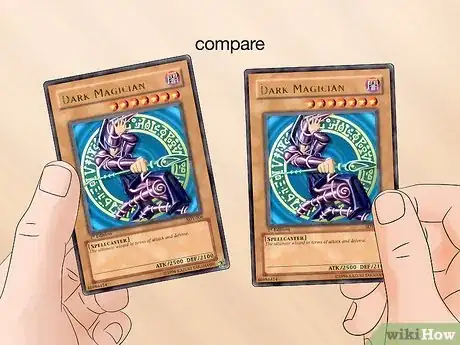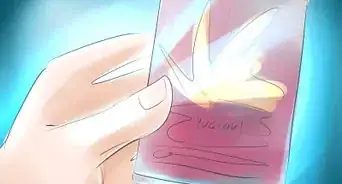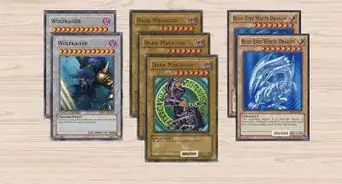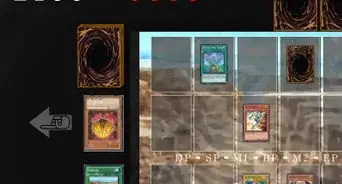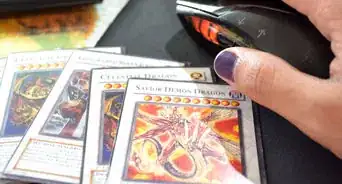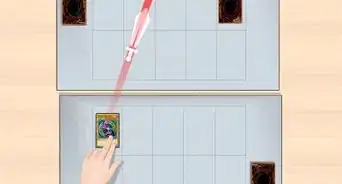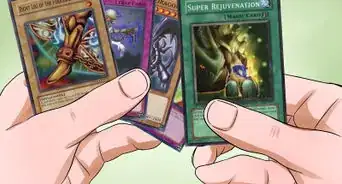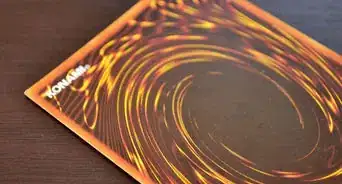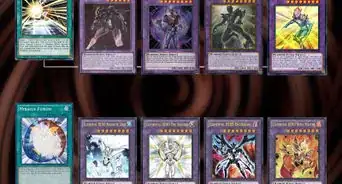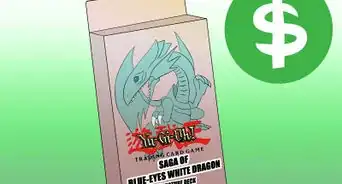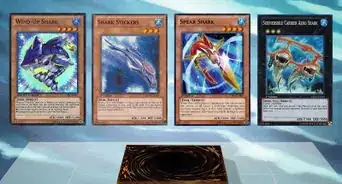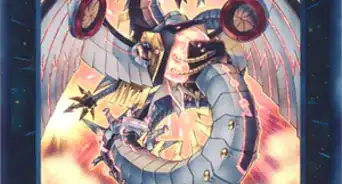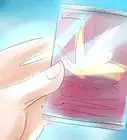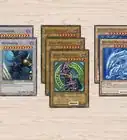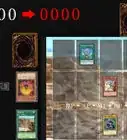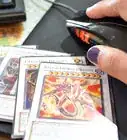This article was co-authored by wikiHow Staff. Our trained team of editors and researchers validate articles for accuracy and comprehensiveness. wikiHow's Content Management Team carefully monitors the work from our editorial staff to ensure that each article is backed by trusted research and meets our high quality standards.
There are 10 references cited in this article, which can be found at the bottom of the page.
wikiHow marks an article as reader-approved once it receives enough positive feedback. In this case, 88% of readers who voted found the article helpful, earning it our reader-approved status.
This article has been viewed 497,084 times.
Learn more...
Collecting Yu-Gi-Oh! cards is a five-star hobby (pun intended), but bootleg sellers can really activate a trap on the fun. Luckily, identifying fake Yu-Gi-Oh! cards is easy. Keep reading and we’ll walk you through the many tell-tale signs of a counterfeit, from stats to design inconsistencies. We'll also offer some good buying practices so you can focus on dominating your opponents with Dark Paladin and Blue Eyes White Dragon (instead of wondering why your Black Cows Magishun and Cyan Face Blue Dinosaur got your deck banned from local tournaments).
Things You Should Know
- Check your card for weird-looking fonts, spelling/grammar errors, and lowercase letters in the card name. If your card has any of the above issues, it’s fake.
- Examine the symbols on your card. If your card is missing an attribute sign at the top right corner or its stars in the top left are designed poorly, it’s a counterfeit.
- Look for design errors like missing: logos, foil stamps in the bottom left, and trademarks.
- Research the cards you plan to buy beforehand. Copy their stats and take pics of what they look like so you have an authentic comparison.
Steps
Checking the Text
-
1Look at the font of the text. If you have a card you’re suspicious of, compare its text to a real card to see if there are differences. If you don’t have a card on hand, look up a genuine card online. Bootleg or fake Yu Gi Oh! cards often have a different font than the real deals.[1]
- The text on a fake card may also have a larger sized font than a real card.
-
2See if there are spelling or grammatical errors in the effect text. Fake cards are often mistranslated or have poorly spelled descriptions. Check the effect text (the text in the bottom box that describes the abilities and uses of the card) for any misspelled words or awkward syntax.[2]
- Check the way the text is arranged too. If a card’s spacing or style is different from the authentic card, then the card is a counterfeit.
- Not all Yu-Gi-Oh! cards have effects. Some cards have what’s called “flavor text,” which gives a fun description of the monster’s lore instead of its in-game powers. Unlike effect text, flavor text is always italicized.
Advertisement -
3Confirm that the effect text is correct. Look up the card online to see what a correct version of its effect text looks like. Then, compare for any changes in wording or phrasing. Even small differences mean the card is counterfeit.[3]
-
4Check for lowercase letters in the card name. All genuine Yu Gi Oh! cards feature the names of the monster or ability in all caps. Examine your card to see if any of the letters in your card’s name are lowercase. If they are, then the card is a counterfeit.[4]
- The effect text will have lower case letters, but the card name will not.
-
5Inspect the brackets and slashes to make sure they’re correct. Yu-Gi-Oh! Cards all have a type: spells, traps, or some form of monster (beast, spellcaster, etc) that are listed inside of brackets with the words separated by a forward slash. Additionally, monster cards also have attack (ATK) and defense (DEF) numbers that are separated by a forward slash.[5]
- Check the spacing as well. Some fake cards will have an extra space before or after the forward slashes.
- Spell and trap cards do not have attack or defense numbers.
- For a full list of monsters and card types, check the Yu-Gi-Oh! Guide.
Finding the Symbols
-
1Inspect the attribute symbol at the top right of the card. The attribute symbol is a Japanese character placed at the top right corner of the card. Above the Japanese character, there’s an English translation overlayed on the symbol. Check to see if the symbol is missing, the English translation is incorrect, or the translation is misspelled.[6]
- The list of possible English translations are: light, dark, fire, water, earth, wind, divine, spell, and trap.
Tip: Some older cards may say magic instead of spell.
-
2Check the top, right, and bottom right points of the level stars. Monster cards will have stars that indicate the level of the card. Level cards are a 5-point yellow star with a red-orange circle around it. The top, right, and bottom right points of the level star will be faded or obscured in the red-orange background. Look closely to see if the stars are solid or different.[7]
- Compare the alignment of the level stars with another genuine card. Some counterfeits will misalign the level stars.
-
3Use different criteria for stars if it’s an Xyz monster card. Yu-Gi-Oh! Xyz Monster cards don't have level stars; they have rank stars, which are designed slightly differently.[8] A rank star is a yellow 5-point star with a black circle surrounding it. This star does not have any of the points faded or obscured in the background. If your Xyz doesn’t have black rank stars or the star points look faded, then the card is fake.[9]
- Rank stars only appear on Xyz monsters. If they’re on another monster card, then that card is fake.
- Xyz monster cards also have black, space-like backgrounds and say “Xyz” in the type brackets above the effect text.
-
4Ensure spell and trap cards don’t have any stars. All spell cards have a green background and say “spell” or “magic” in the brackets above the effect text. All trap cards have a pink background and say “trap” in these same brackets. Neither spell or traps have level or rank stars. If your spell or trap card doesn’t match any of the above criteria, that means it’s fake.[10]
Looking at the Design of the Card
-
1Look for rounded corners on the card. All genuine Yu Gi Oh! cards have a black border that features rounded edges at the corners of the card. Check to see if the card has pointed or angled corners. If it does, then it’s a counterfeit.[11]
- Be wary of cards with corners that are rounded off too much as well.
-
2Feel the surface of the card with your finger to check the texture. Rub the surface of the card with your fingertip to feel the texture of it. Real cards feel glossy and have a raised surface to reflect the features of the art, while fake cards feel flat and rough.[12]
-
3Check to see if the borders of the card are miscut. Check both the front and back of the card to see if its borders are uneven or miscut. If they are, this means the card is counterfeit.[13]
-
4Inspect the foil stamp in the bottom right corner of the card. Authentic cards will have a shiny, square stamp on the bottom right corner of the front of the card with the words “Yu-Gi-Oh!” in small, horizontal script. Fake cards may be missing the foil stamp or the letters may be arranged vertically.[14]
- The color of a real card’s foil will be either gold or silver. Any other color is a counterfeit.
- All Yu-Gi-Oh! cards also have an edition number on the right hand side right above the effect text box. If your card is missing a number, it’s fake.
Tip: Gold colored foil indicates that the card is a first edition or a limited edition. This means it’s super valuable! If the card is labeled or sold as a first or limited edition, but has a silver foil stamp, it’s a fake.
-
5Confirm the design, logo, and trademark on the back are correct. The back of Yu-Gi-Oh! Cards have a dark orange swirl with a black, portal-like oval in the center. On the bottom right hand corner, there’s an official Yu Gi Oh! Logo with a trademark symbol. Check to see if any of these features are missing or in the wrong location. If they are, then the card is fake.[15]
- The border on the back of the card should be slightly thicker than the border on the front of the card.
Using Good Buying Practices
-
1Research the cards you plan to purchase. Learn all the traits and stats of your Yu-Gi-Oh! cards beforehand. Visit the official Yu Gi Oh! website so you can be certain you have accurate information. Then, write down this info so you can reference it when you make your purchases. [16]
- Also check Yu-Gi-Oh! Prices to see the average going rate for each card. If someone is selling a card worth 500 bucks for $9.50, it’s probably not the real deal.
- Check online forums for information about the cards and what counterfeit versions may look like.
- Avoid buying from unofficial websites like AliExpress altogether.
-
2Check the name and stats of the cards you buy. Even if you buy your cards from a major retail store or the packaging is sealed, you can’t necessarily trust that they’re authentic. Confirm the cards are genuine before adding them to your deck by making sure that the card is correctly named and contains the real stats.[17]
- These stats include the attributes as well as the level or rank.
- Some Yu-Gi-Oh! cards have been slightly renamed because they’ve been added to a unique archetype. For example, "Kinetic Soldier” became “Cipher Soldier” when the “Cipher” card collection was released. Both the renamed cards and the original cards are considered authentic.
- If the name of your card looks suspicious, check the list of renamed cards to ensure it’s been legitimately renamed and isn’t just a bootleg.
-
3Avoid cards sold in sets of multiple packs of cards. Only buy unopened sets of Yu Gi Oh! cards that come in a 9 card single package. Counterfeit cards are often sold in packages containing more than 9 cards or as sets of multiple packs.[18]
- Sets of 3 packs for discounted prices are dead giveaways that the cards are fake.
-
4Compare 2 of the same cards to spot differences. Whether you plan to buy cards online or in-person, always contrast the sold cards with authentic versions so you can look for any differences. If the cards that they’re trying to sell you have any discrepancies, then they’re fake.[19]
- Some online Yu-Gi-Oh! Sellers will write “orica” next to the cards they’re listing. “Orica” stands for “original card,” which means the card isn’t real. Oricas are not bootlegs; they’re original pieces designed by Yu-Gi-Oh! fans and hobbyists with their own style. While you can’t play with them, they still have pretty cool and unique designs and might be worth buying as collectibles.
Community Q&A
Did you know you can get answers researched by wikiHow Staff?
Unlock staff-researched answers by supporting wikiHow
-
QuestionCan I report the fake cards?
 wikiHow Staff EditorThis answer was written by one of our trained team of researchers who validated it for accuracy and comprehensiveness.
wikiHow Staff EditorThis answer was written by one of our trained team of researchers who validated it for accuracy and comprehensiveness.
Staff Answer wikiHow Staff EditorStaff Answer
wikiHow Staff EditorStaff Answer -
QuestionMy uncle ordered over 200 Yu-Gi-Oh! cards on Ebay. They meet all the requirements to be real, but I feel like they're fake. Are they real?
 wikiHow Staff EditorThis answer was written by one of our trained team of researchers who validated it for accuracy and comprehensiveness.
wikiHow Staff EditorThis answer was written by one of our trained team of researchers who validated it for accuracy and comprehensiveness.
Staff Answer wikiHow Staff EditorStaff Answer
wikiHow Staff EditorStaff Answer -
QuestionI have a card which i can not find anywhere on the web. It's called "TWO THOUSAND THORN HEDGE PIG." Is it fake?
 wikiHow Staff EditorThis answer was written by one of our trained team of researchers who validated it for accuracy and comprehensiveness.
wikiHow Staff EditorThis answer was written by one of our trained team of researchers who validated it for accuracy and comprehensiveness.
Staff Answer wikiHow Staff EditorStaff Answer
wikiHow Staff EditorStaff Answer
References
- ↑ https://youtu.be/4OSJsG-9qbI?t=66
- ↑ https://www.cbr.com/yu-gi-oh-worst-bootleg-cards-shadow-realm/#endless-dragon-with-blue-eyess
- ↑ https://youtu.be/I2Q6yGuuTQ8?t=581
- ↑ https://www.yugiohcardguide.com/fake-yugioh-cards/
- ↑ https://www.yugiohcardguide.com/fake-yugioh-cards/
- ↑ https://www.yugiohcardguide.com/fake-yugioh-cards/
- ↑ https://youtu.be/4OSJsG-9qbI?t=144
- ↑ https://yugiohblog.konami.com/articles/?p=3067
- ↑ https://www.yugiohcardguide.com/fake-yugioh-cards/
- ↑ https://www.yugiohcardguide.com/fake-yugioh-cards/
- ↑ https://www.yugiohcardguide.com/fake-yugioh-cards/
- ↑ https://youtu.be/I2Q6yGuuTQ8?t=91
- ↑ https://youtu.be/I2Q6yGuuTQ8?t=117
- ↑ https://www.laweekly.com/are-your-yu-gi-oh-cards-bogus-how-to-tell-the-real-ones-from-the-fakes/
- ↑ https://www.yugiohcardguide.com/fake-yugioh-cards/
- ↑ https://www.yugiohcardguide.com/fake-yugioh-cards/
- ↑ https://www.yugiohcardguide.com/fake-yugioh-cards/
- ↑ https://www.laweekly.com/are-your-yu-gi-oh-cards-bogus-how-to-tell-the-real-ones-from-the-fakes/
- ↑ https://yugioh.fandom.com/wiki/Counterfeit
